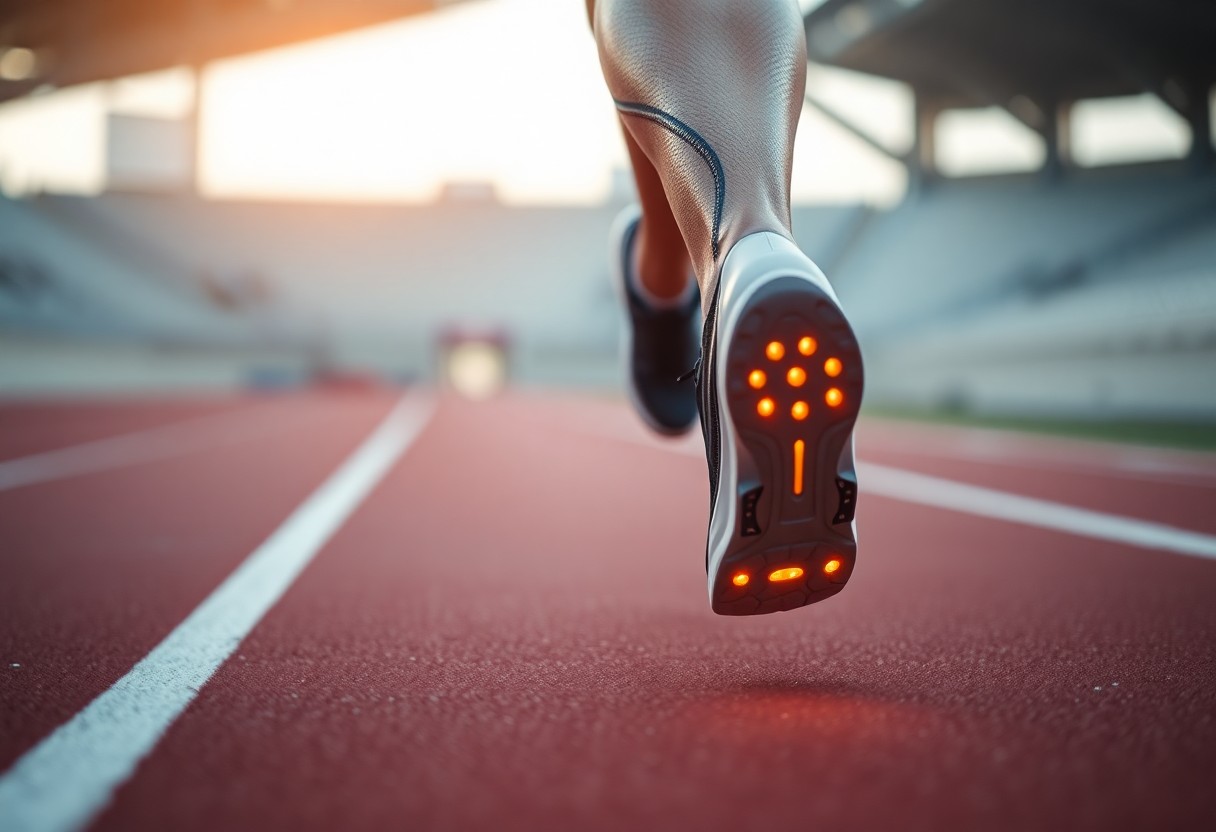
Discover the revolutionary advancements in running footwear technology that have redefined the performance capabilities for endurance athletes. These innovations have not only changed how athletes approach training but have also significantly enhanced their competitive edge.
The optimisation of performance in endurance running has experienced a remarkable transformation thanks to advanced footwear technology. This cutting-edge innovation presents unprecedented opportunities for enhancing your athletic potential. You will learn how innovative shoe designs can drastically lower your metabolic expenditure and boost your running economy. By incorporating carbon fibre plates and state-of-the-art midsole materials, these shoes deliver exceptional energy return mechanisms, potentially reducing your oxygen consumption by as much as 4%. Whether you are a seasoned professional or an enthusiastic amateur, comprehending these biomechanical advancements will empower you to make well-informed decisions regarding your running gear and optimise your race times.
 Continue reading to delve deeper into the mechanics of running footwear that promise to significantly enhance your performance:
Continue reading to delve deeper into the mechanics of running footwear that promise to significantly enhance your performance:
Unpacking Energy Return Mechanisms in Advanced Running Footwear
Advanced running shoe technology employs intricate biomechanical principles to revolutionise energy transfer during locomotion. With innovative design features working together, these shoes effectively minimise metabolic expenditure, creating a highly efficient system that optimises running efficacy via strategic material engineering and geometry. By concentrating on the mechanics of energy return, these advanced shoes provide runners with a considerable advantage in both performance and stamina, allowing for longer runs with less fatigue.
Diving into the Curvature Dynamics of Carbon Fibre Plates
Carbon fibre plates utilise precise geometric engineering to redirect kinetic energy throughout the running motion. Optimal curvature angles ranging from 12° to 15° facilitate maximum energy storage and return, with finite element modelling showing energy return efficiency of up to 93% in prototype designs. These meticulously engineered plates create a spring-like effect that alleviates muscular strain during the toe-off phases, enabling runners to conserve energy over extended distances, thereby enhancing endurance and performance.
Comparative Analysis of TPU and EVA in Midsole Innovations
Material selection plays a pivotal role in shoe performance, with thermoplastic polyurethane (TPU) emerging as a superior choice for midsole technology. Comparative analyses highlight TPU’s distinct advantages in energy return and impact absorption, granting runners enhanced biomechanical efficiency across varied running conditions. The decision between TPU and EVA foam is vital for athletes seeking to optimise their performance while minimising injury risks during training and competitive events.
| Energy Return | 18% higher in TPU |
| Oxygen Consumption Reduction | 2.4% lower with TPU |
A thorough investigation into midsole materials reveals nuanced performance characteristics. TPU demonstrates superior resilience compared to traditional EVA foam, retaining consistent mechanical properties across thousands of compression cycles. Runners benefit from more reliable energy return, reduced fatigue, and enhanced long-distance performance through advanced material science innovations, which can have a major impact on their overall training and competition outcomes.
| Impact Absorption | TPU absorbs 37% more force |
| Rebound Elasticity | 89% maintained across 50,000 cycles |
 Continue exploring the effects of advanced footwear technology on metabolic efficiency:
Continue exploring the effects of advanced footwear technology on metabolic efficiency:
Evaluating Metabolic Efficiency: Identifying Who Gains the Most from Advanced Footwear
The impact of advanced footwear technology on runners is not uniform. Gains in metabolic efficiency differ significantly across various demographic groups, with factors such as gender, age, and individual biomechanics playing essential roles in performance enhancement. Studies have revealed intricate patterns of metabolic response, indicating that the advantages of super shoes extend beyond basic performance metrics to encompass complex physiological adaptations that are unique to each runner’s biomechanical profile.
Investigating Gender-Specific Performance Enhancements
Female runners demonstrate a 3.2% improvement in metabolic power, while males experience a 4.2% increase, suggesting intricate neuromuscular adaptations. Data on pelvic kinematics reveals a 14% greater reduction in hip adduction angle among females using advanced footwear, which may elucidate the subtle differences in metabolic gains between genders. Recognising these distinctions can aid in tailoring training and footwear choices to maximise performance benefits for each gender.
Understanding Age-Related Benefits and Their Influence on Endurance Performance
Athletes aged 40 and above show a 2.8% greater reduction in oxygen costs when utilising super shoes, likely compensating for diminished tendon elasticity. Tibial loading analyses indicate a 12% cumulative stress reduction per kilometre in older runners, which suggests potential advantages in injury prevention and performance maintenance. These findings underscore the significance of advanced footwear technology in prolonging the competitive lifespan of older athletes.
The benefits associated with advanced footwear technology for older athletes extend well beyond basic performance metrics. Biomechanical studies reveal that older runners experience more pronounced adaptations due to compensatory mechanisms. Reduced tendon stiffness and altered muscle recruitment patterns work in conjunction with shoe technology to create a unique performance enhancement profile. Specifically, the energy return mechanism of the carbon plate appears to counteract age-related biomechanical inefficiencies, potentially extending the competitive running careers of older athletes by alleviating the physiological constraints that typically accompany aging.
Continue reading to discover more about the implications of advanced footwear technology concerning injury risks:
Assessing the Implications of Running Footwear on Injury Risks
The introduction of advanced footwear technology brings about intricate biomechanical interactions that necessitate a careful examination of potential injury risks. Runners must thoughtfully weigh the trade-offs between performance enhancement and physiological adaptation. Longitudinal studies have identified subtle yet significant alterations in muscular recruitment patterns, joint loading, and proprioceptive feedback when transitioning to high-performance running shoes, highlighting the need for a balanced approach to training and recovery.
Injury Analysis: Evaluating the Costs of Enhanced Performance
Research in biomechanics indicates a 9% increase in Achilles tendon strain rates among users of super shoes during high-intensity training. Plantar pressure mapping shows a 22% increase in forefoot loading compared to conventional trainers, particularly during demanding conditions such as downhill running. These findings suggest that while metabolic efficiency improves, runners must implement targeted strength training and adaptation protocols to mitigate potential injury risks and safeguard long-term athletic health.
Modifying Training Protocols for Optimal Gait Adaptations
Your biomechanical response to advanced footwear necessitates strategic adjustments in your training regimen. Gait retraining is crucial to optimising the unique energy return mechanisms inherent in carbon-plated shoes. Runners should concentrate on developing neuromuscular patterns that align with the shoe’s biomechanical design, potentially reducing injury risks while maximising performance benefits.
Thorough gait adaptation strategies involve multifaceted approaches to effectively integrate advanced footwear technology. Biomechanical analysis indicates that runners typically require around 6-8 weeks of progressive training to fully acclimatise to the unique mechanical properties of super shoes. This adaptation period should include focused eccentric strengthening protocols, modified interval training strategies, and vigilant monitoring of lower limb biomechanics. Professional athletes and dedicated runners can greatly benefit from periodic 3D gait analysis to track subtle shifts in movement patterns, ensuring optimal integration of advanced footwear technology with their individual biomechanical characteristics.
 Explore the future of footwear technology and its implications for runners:
Explore the future of footwear technology and its implications for runners:
Envisioning Future Innovations in Running Footwear Technology
Emerging advancements are set to revolutionise running shoe design, pushing the limits of biomechanical efficiency and performance optimisation. Cutting-edge research is focused on personalised solutions that adapt to individual biomechanics, utilising advanced materials, computational modelling, and integrated sensor technologies to forge a new generation of intelligent footwear designed specifically for elite athletes.
Transforming Footwear Design with 3D Printed Midsoles
Lattice structure optimisation algorithms now facilitate precise regional stiffness variations that correspond to individual foot pressure maps. Prototype testing has demonstrated 5.1% additional metabolic savings compared to mass-produced models, with computational design enabling unparalleled customisation of midsole geometries to optimise energy return and minimise biomechanical stress. This innovative approach guarantees that every runner can achieve optimal performance tailored to their unique physical traits.
Integrating Smart Technology for Enhanced Performance Monitoring
New sensor technologies are transforming conventional running shoes into sophisticated performance tracking devices. Real-time ground reaction force feedback systems can reduce oxygen costs by 1.9% through micro-adjustments in cadence, offering runners immediate biomechanical insights during both training and competition. These advancements are crucial for athletes keen to fine-tune their technique and performance metrics.
The integration of advanced sensors signifies a substantial leap forward in performance monitoring technology. Multi-axis accelerometers, pressure-sensitive matrices, and embedded microprocessors now capture intricate biomechanical data with unparalleled accuracy. These intelligent systems analyse gait mechanics, impact forces, and energy expenditure in real-time, granting runners detailed insights into their movement patterns. Machine learning algorithms can now anticipate potential injury risks, optimise training loads, and recommend personalised technique modifications based on comprehensive movement analyses, transforming running shoes from mere equipment to proactive performance optimisation tools.
Finally, gain a comprehensive understanding of the transformative landscape surrounding advanced footwear technology in endurance running:
Embracing the Future of Advanced Footwear Technology in Endurance Running
In summary, you have explored the transformative landscape of advanced footwear technology in endurance running. Your insights now encompass how innovative design features, such as carbon plates and high-performance midsole materials, can substantially lower metabolic costs and enhance running efficiency. By leveraging scientific insights, you can appreciate that these shoes offer more than just incremental gains—they signify a significant shift in athletic performance. Your investment in such technology could lead to improved running economy, reduced energy expenditure, and optimised biomechanical responses across diverse athletic demographics.
The Article Biomechanical Efficiency of Advanced Footwear Technology: Metabolic Cost Reduction and Performance Enhancement in Endurance Running appeared first on My Shoes Finder.
The Article Biomechanical Efficiency in Advanced Footwear for Runners Was Found On https://limitsofstrategy.com






